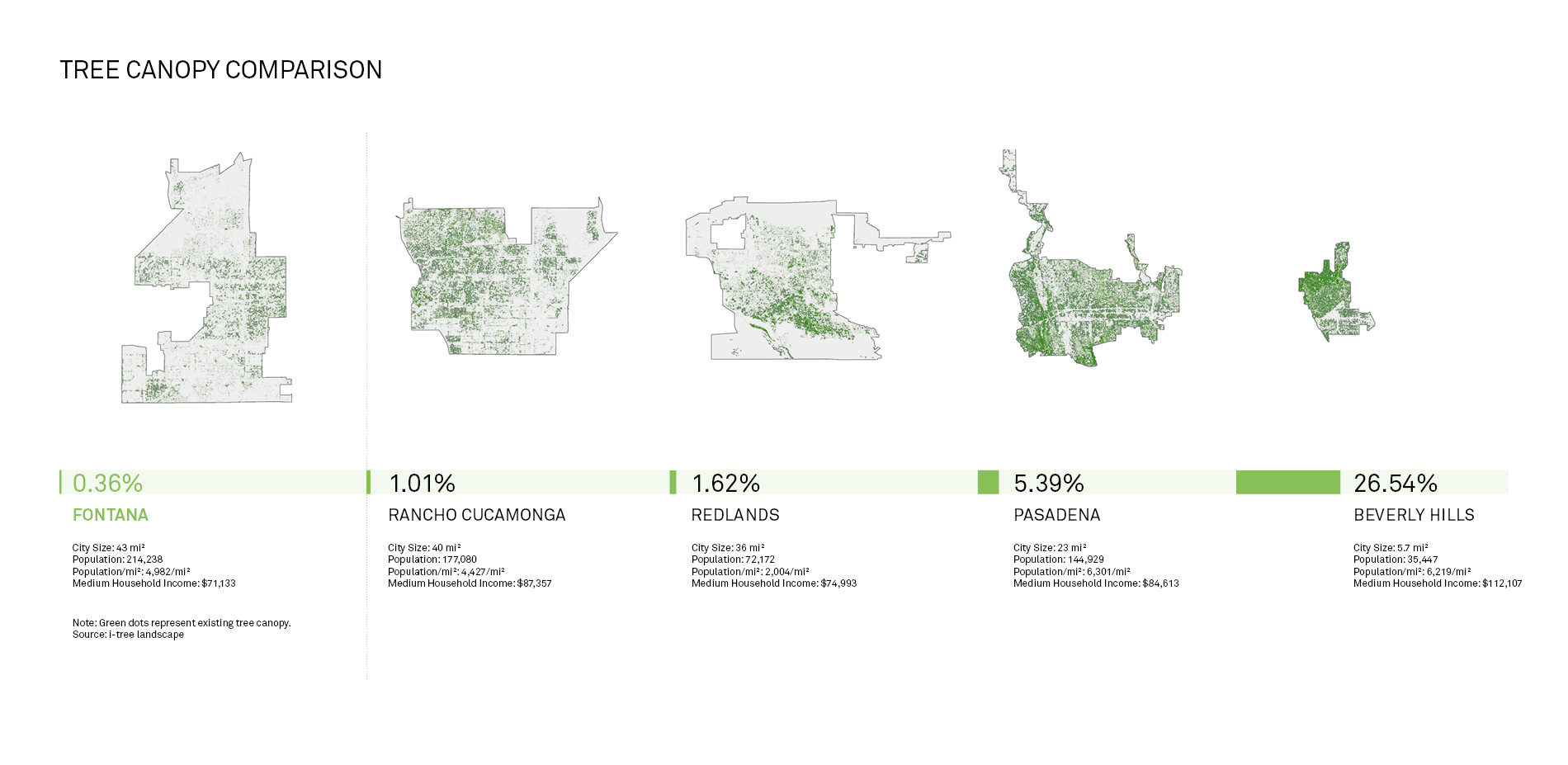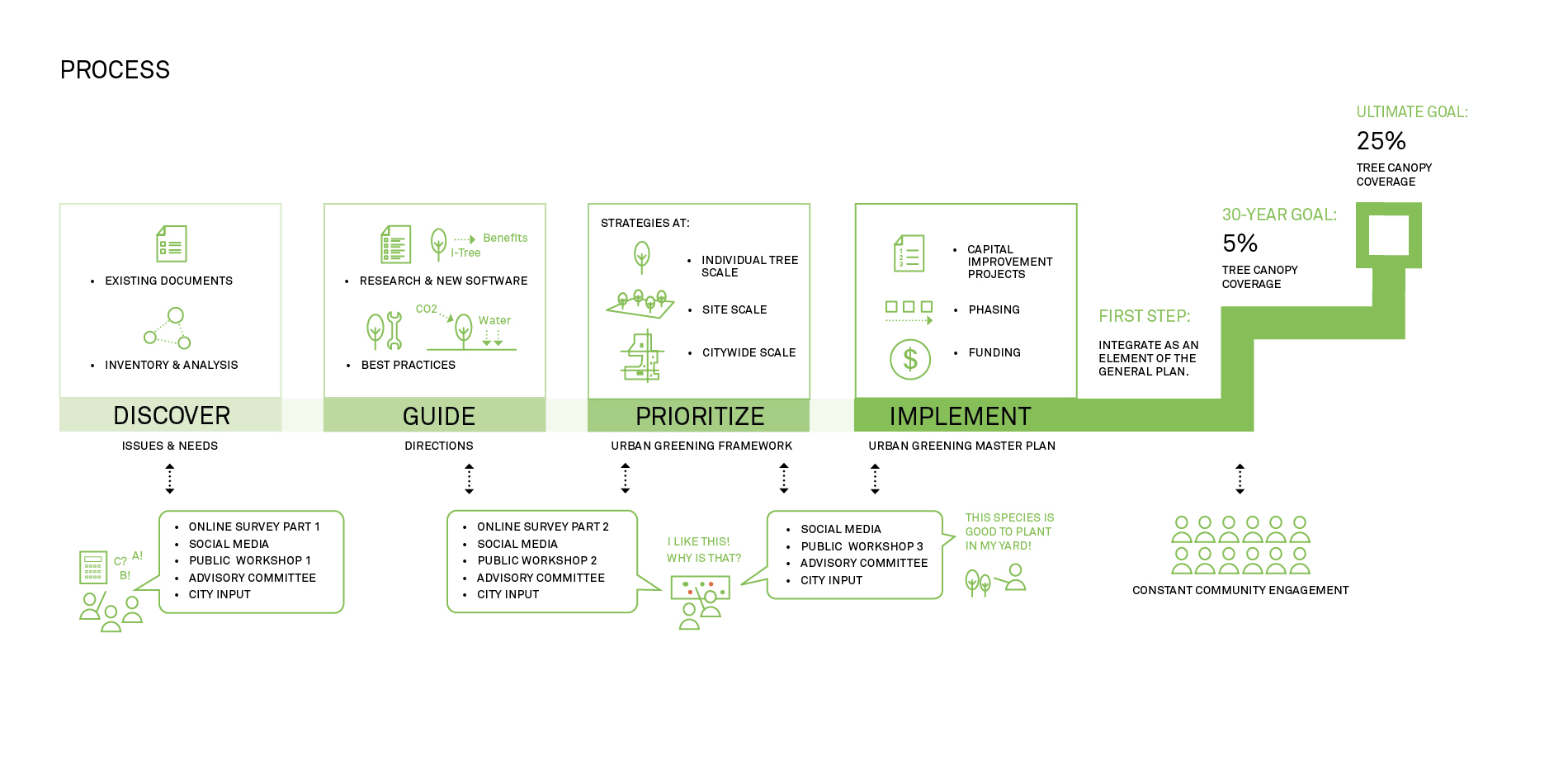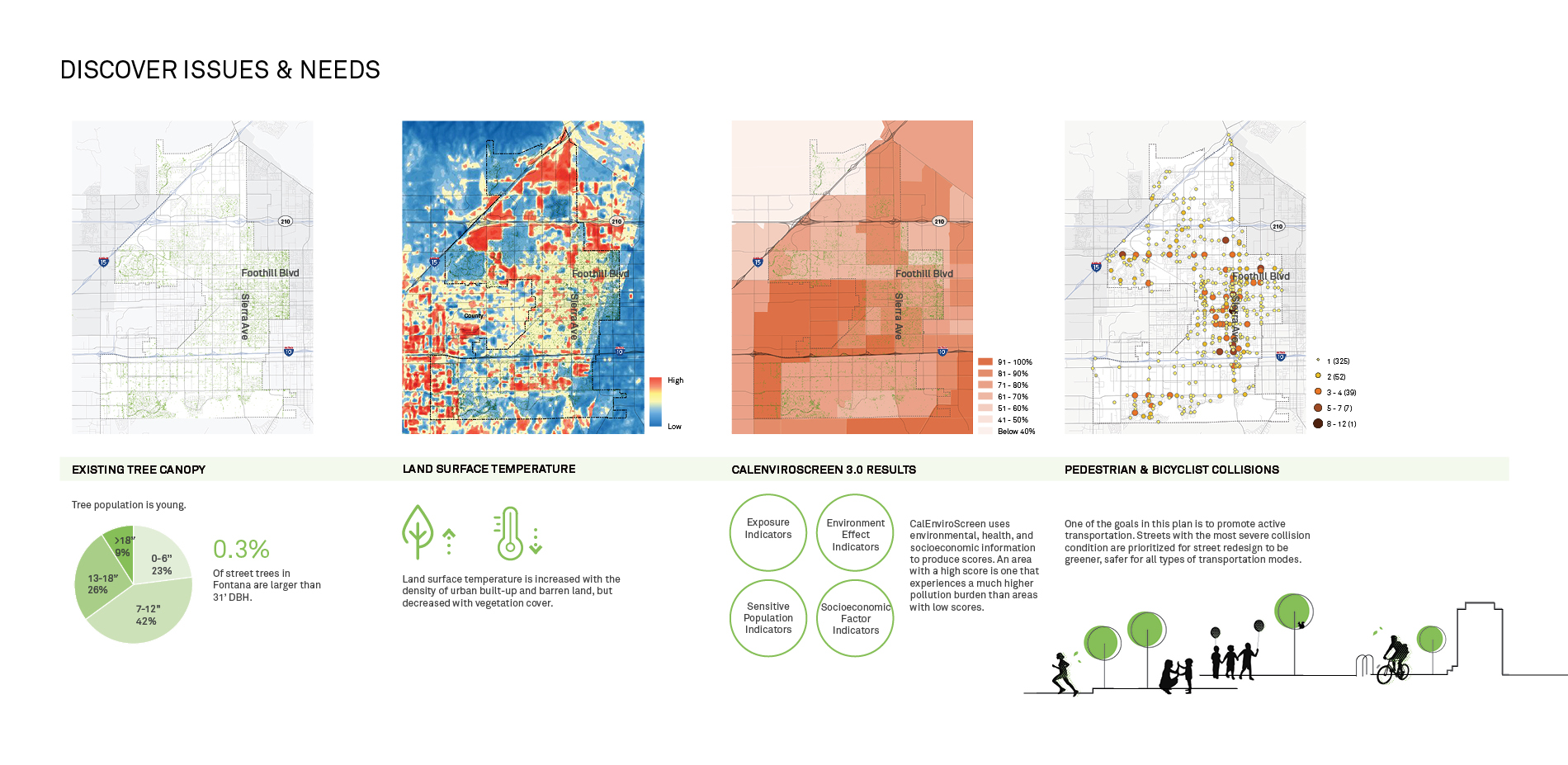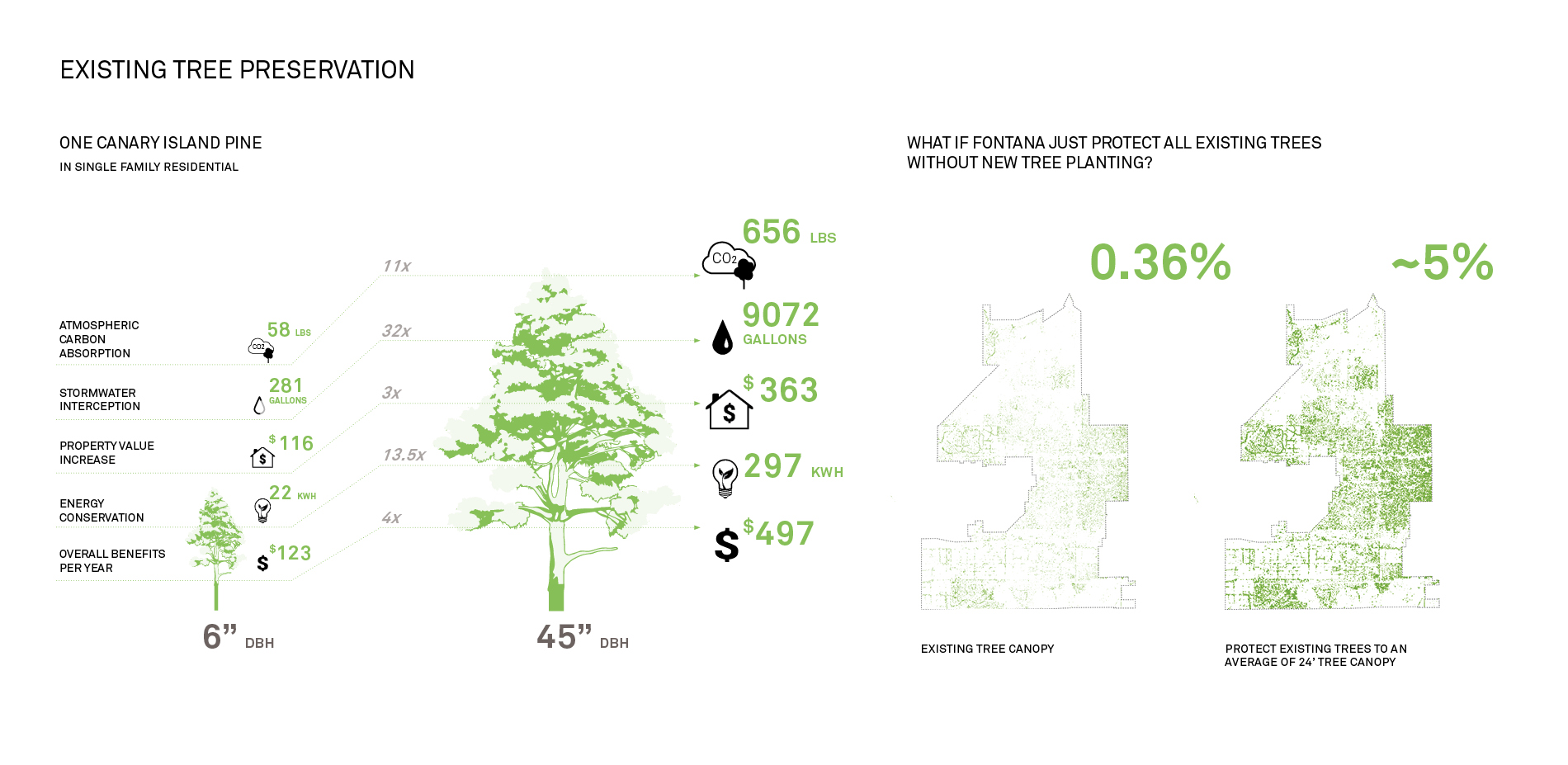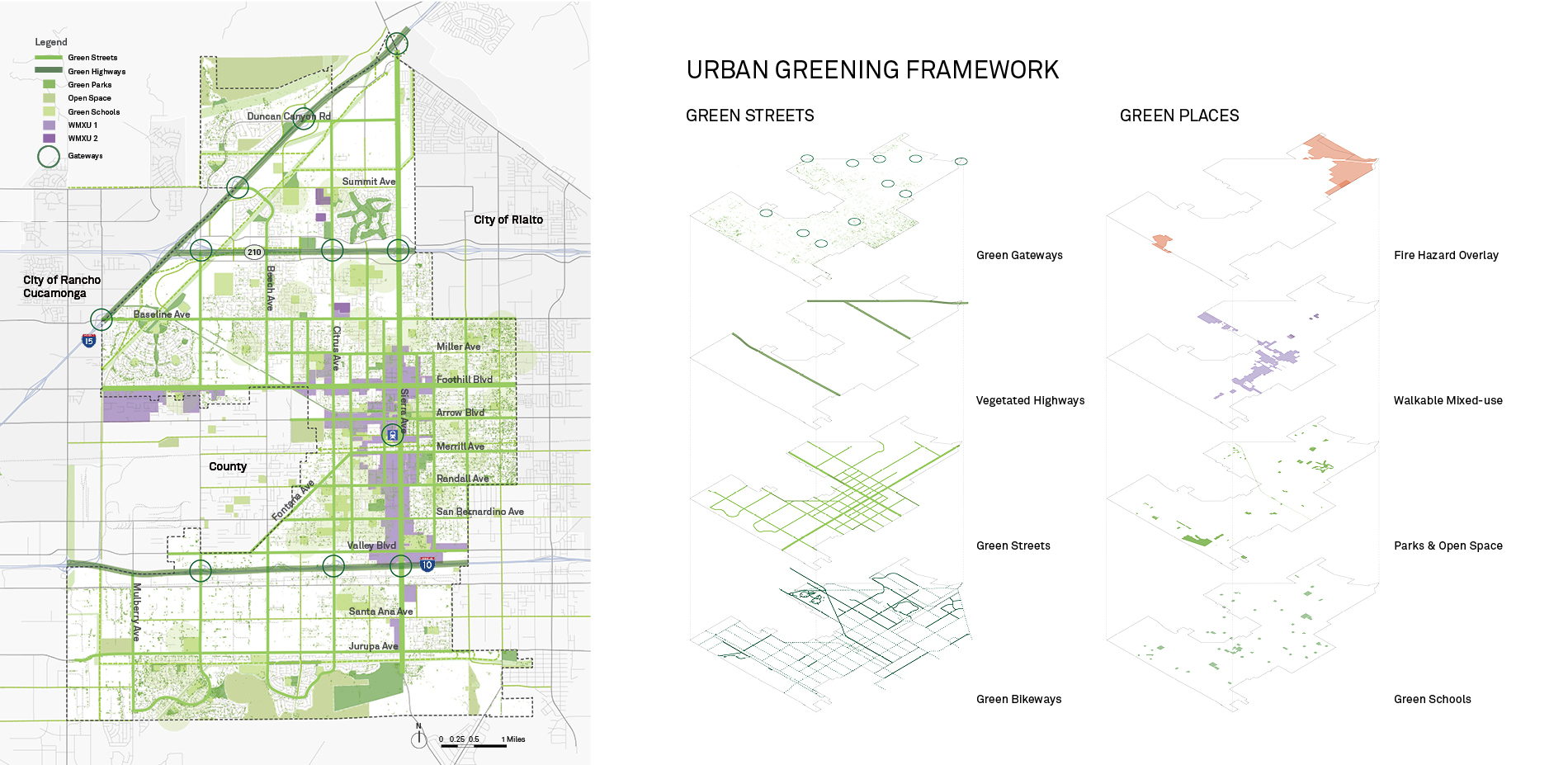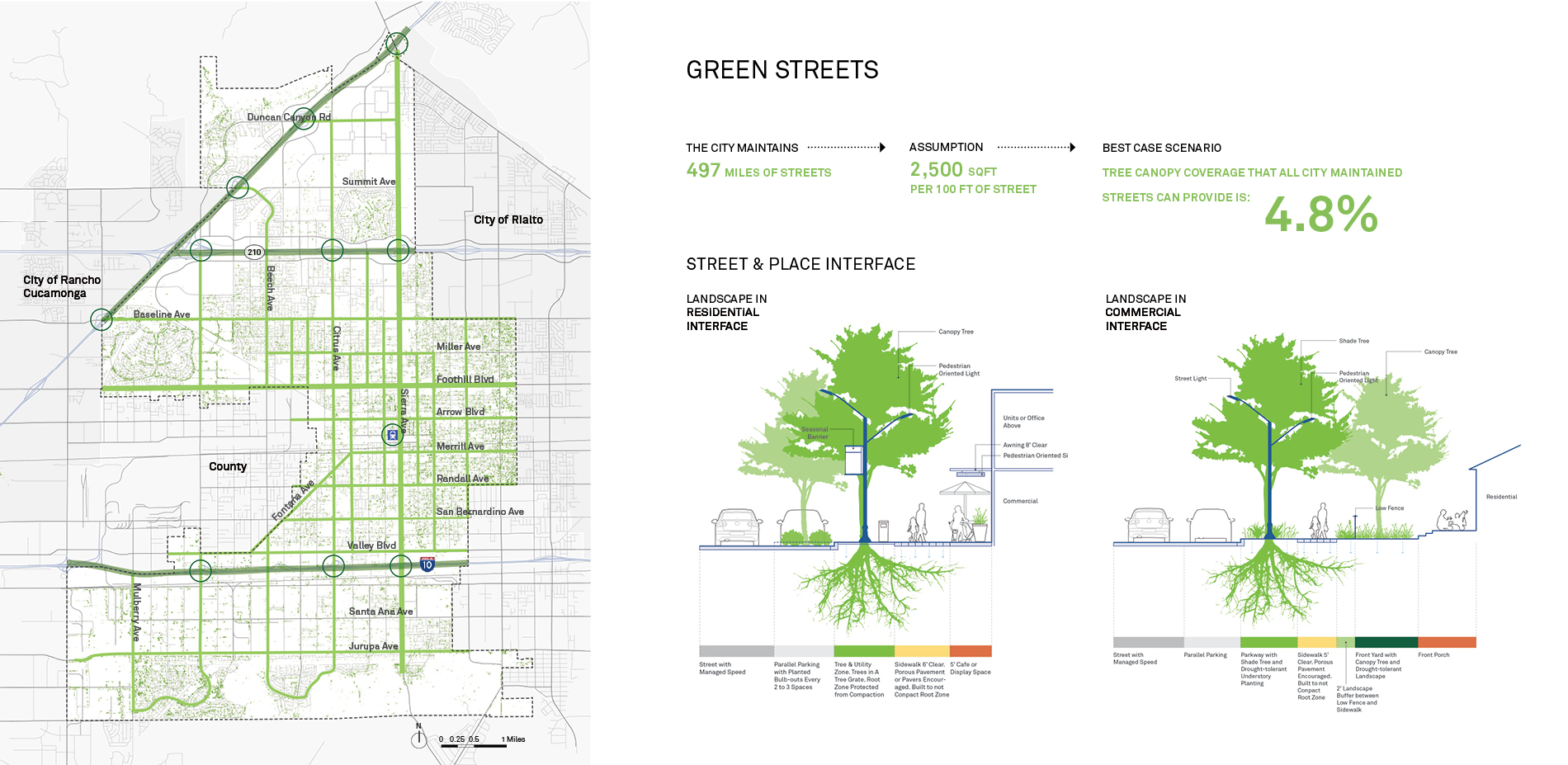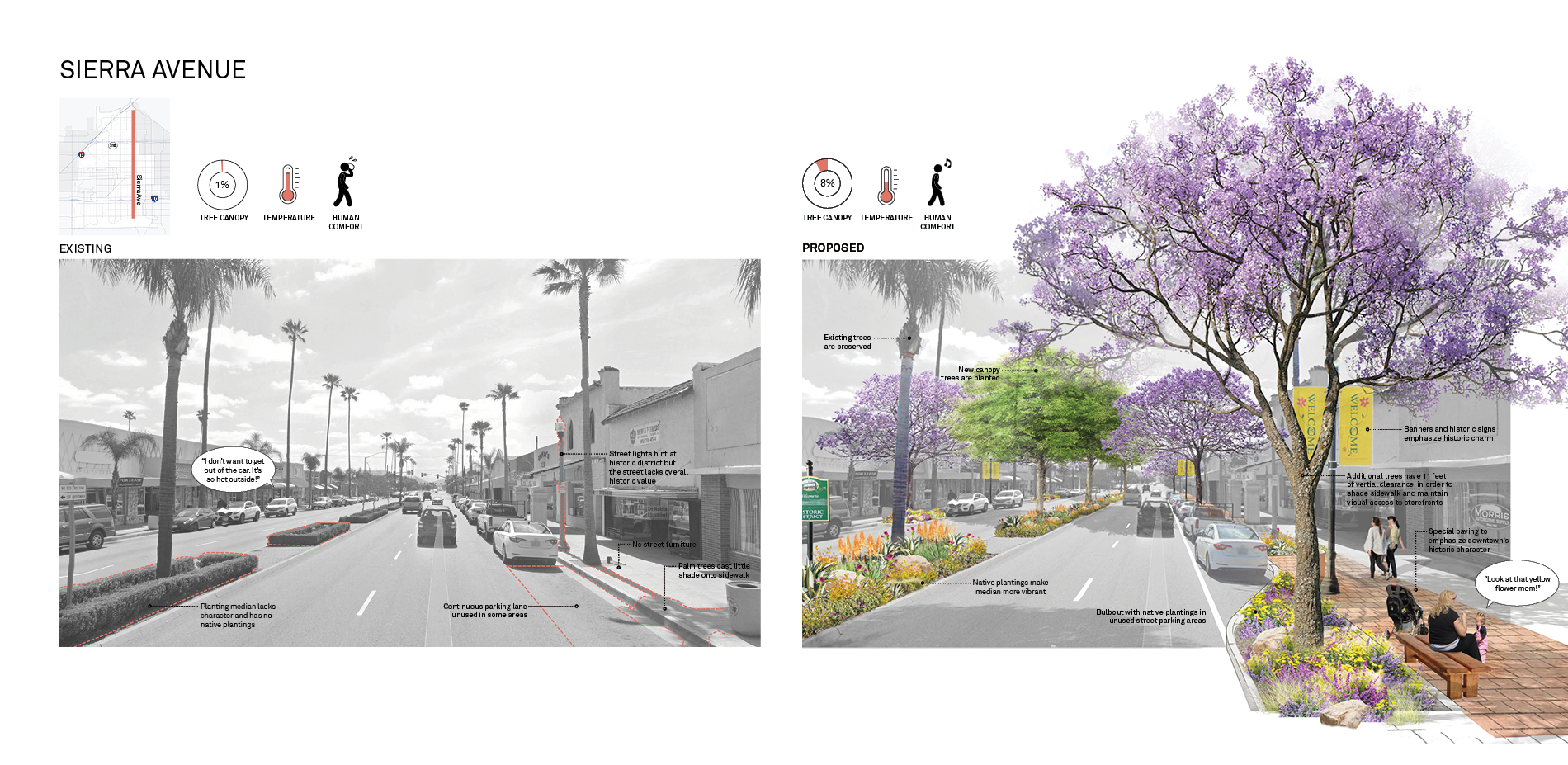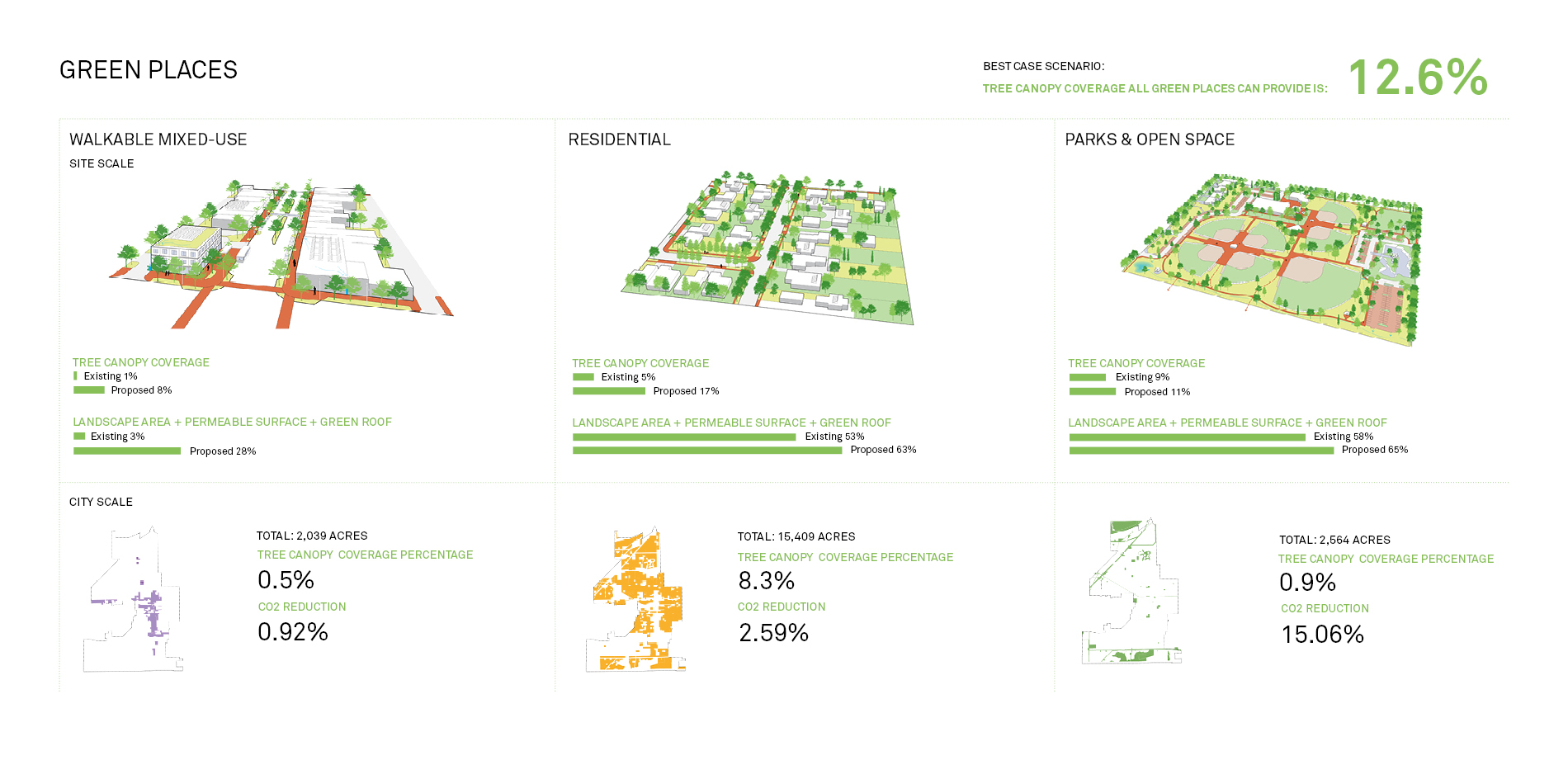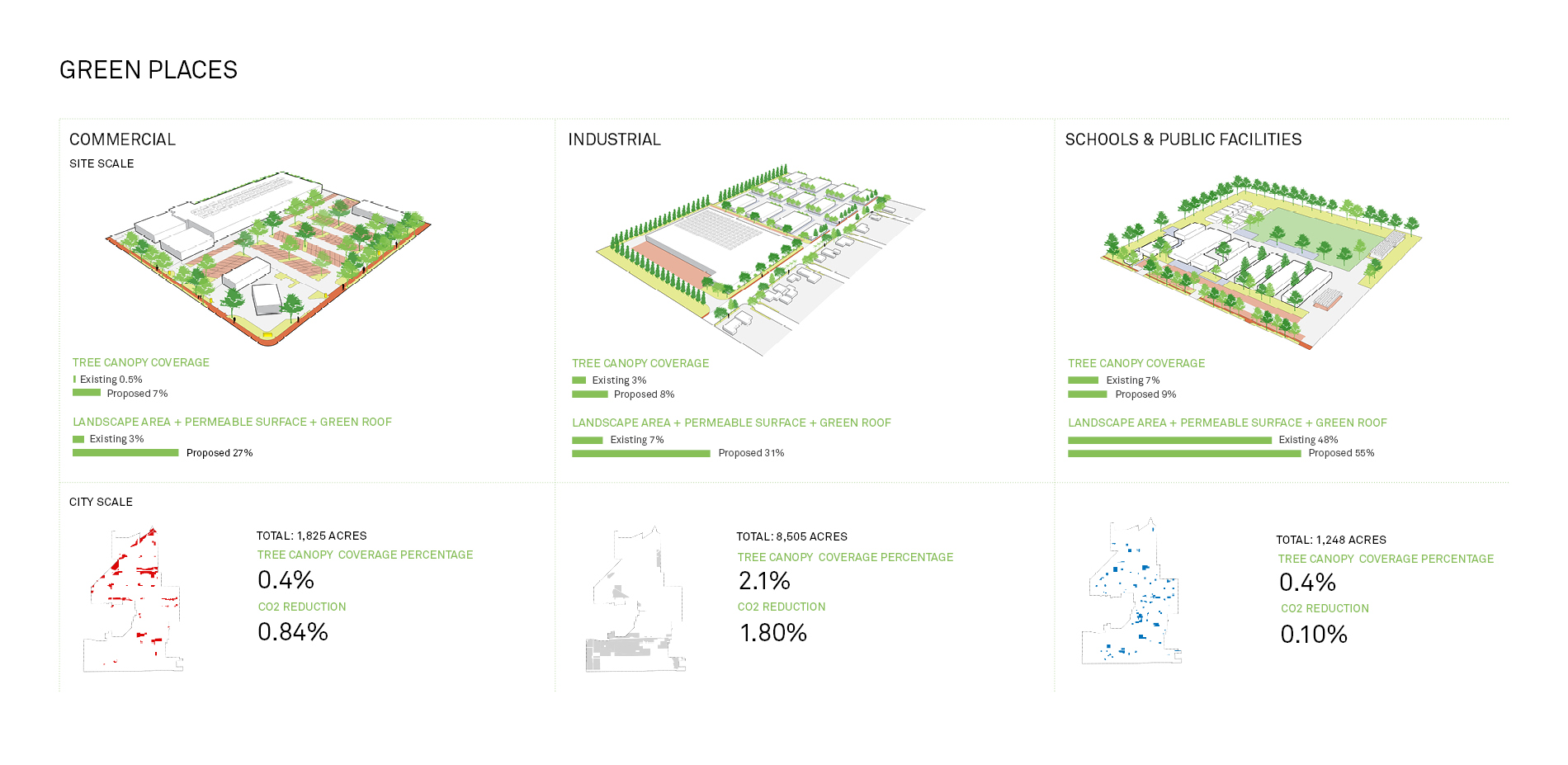Air Quality, Placemaking and Spatial Equity: The Fontana Urban Greening Master Plan
Honor Award
Analysis and Planning
Fontana, California, United States
Design Workshop, Inc.
Client: Southern California Association of Goverments and the City of Fontana
In the heart of Southern California’s Inland Empire, Fontana is a growing city within a largely commercial setting. Considering the issues of air quality issues resulting from its position at the base of the San Bernadino Mountains for current and future residents, city officials have worked to develop a three-decade plan to increase overall tree coverage—currently just 0.36 percent—to improve air quality and create a more hospitable environment. By preserving existing trees and re-sizing several thoroughfares to emphasize canopy over cars, Fontana has set a framework that will reduce its emissions and improve spatial equity for its residents.
- 2020 Awards Jury
Project Credits
Kurt Culbertson, Principal-In-Charge (Design Workshop, Inc.)
Jason Ficht , Project Manager (Design Workshop, Inc.)
Xiaojian Fan, Project Landscape Designer (Design Workshop, Inc.)
Chen Liu, Project Landscape Designer (Design Workshop, Inc.)
Zachary Zabel, Transportation Planner (Nelson\Nygaard)
Nate Hines, Irrigation Design Lead (Hines Inc.)
Edward Wranosky, Irrigation Designer (Hines Inc.)
James Komen, Arborist (Class One Arboriculture)
Project Statement
Landlocked within California’s semi-arid Inland Empire, residents of Fontana are exposed to air quality that is worse than 95% of census tracts in California. Its urban forest – a mere 0.36% coverage – is distinctly less than other communities in Los Angeles Basin. This statistic, when considered with the influence of major transportation corridors, notable industrial hubs, frequent regional wildfires, and projected population growth, is at further risk as outdated and unconsolidated landscape regulations face increased development pressures.
Grounded by quantitative research, the Fontana Urban Greening Master Plan applies scientific knowledge to explore various dimensions of air quality. In doing so, the Plan creates a multi-scalar, green infrastructure vision that influences development patterns, improves individual health, and creates a resilient future for Fontana. Through bilingual community engagement, the design team implemented a four-step planning process – Discover, Guide, Prioritize, and Implement. Transferable in its approach for other communities, the Plan achieved immediate policy change with its ambitious, long-term goal of increasing tree canopy coverage to 5% by 2050 – a transformational increase of over 1300%.
Project Narrative
THE URGENCY OF URBAN GREENING
Air pollution causes over 50,000 deaths each year in the United States and numerous other illnesses. Geographically landlocked, the Inland Empire of Southern California consistently ranks at the top of national lists for poorest air quality. Prevailing Santa Ana winds, when combined with eastward Pacific winds, trap air pollution generated within the Basin against a perimeter of mountains. This pattern, when exacerbated by abundant solar radiation, ozone, volatile organic compounds and fine particulate pollution, produces smog.
Resting near the base of the San Bernardino Mountains, Fontana (pop. 210,000) is transected by three major highways and comprised of heavy commercial and industrial use with large expanses of pavement and tracts of vacant land. The city is ethnically diverse – 71% identified as Hispanic origin – and possesses a median household income of $71,000, with lower income demographics concentrated mid-city. For those seeking affordability, Fontana is an attractive option with population growth projected at 4.4% over the next five years. However, existing landscape regulations are outdated, unconsolidated and inconsistently implemented, causing confusion and prolonged approvals as new developments rapidly emerge.
PURPOSE
Recognizing these statistics, the City of Fontana and The Southern California Association of Governments (SCAG) commissioned the landscape architect to craft an Urban Greening Master Plan to increase citywide tree canopy, improve multi-modal mobility, catalyze economic development, consolidate various regulations, and update policies to improve visual character, conserve water and reduce maintenance. Furthermore, the Plan would build upon the recently adopted Fontana Forward General Plan, Active Transportation Plan, and the California Model Water Efficient Landscape Ordinance. Beyond such goals, the landscape architect elevated the project’s purpose to explore how such a plan can directly improve air quality.
LUNGS OF THE CITY
For centuries, landscape architects have taken it on faith that parks are the ”Lungs of the City”, capable of improving air quality. But to what degree? Can landscape architects support what we take as faith with proven scientific evidence? Surprisingly, little empirical data and research has been applied to this principle. To our knowledge, our Plan is the first known attempt to gather such research, calculate benefits and communicate impacts informed by science.
COMMUNITY ENGAGEMENT
Through a bilingual engagement process, the team implemented a four-step planning process – Discover, Guide, Prioritize, and Implement. Three community workshops and two online surveys solicited feedback on visual preferences, priorities and vision, and tested the community’s openness and acceptance of “browner” native, drought-tolerant landscape versus lush, green, over-irrigated non-native landscape that currently dominates portions of the city. Changing perceptions, the adopted plant palette now includes overwhelmingly native and water-efficient planting materials. The process helped citizens move beyond initial perceptions of a “beautification” project, instead educating them on the multiple benefits of trees and how urban greening can support their goals of becoming a complete community.
SPATIAL EQUITY
Past research has drawn correlation between canopy coverage and income levels, concluding that the impact of air pollution and urban heat island falls disproportionately upon people of color and lower income populations. This correlation holds true in Fontana. As such, the Plan addresses spatial equity by improving conditions for all residents. Initial steps educated and established baseline metrics and targets as compared to peer cities within the Basin. With only 0.36% of the city’s land area possessing tree coverage, Fontana falls well below cities with similar demographics, including Rancho Cucamonga and Redlands. When compared to more affluent communities like Beverly Hills, the gap widens. At a city-scale, overlays of demographics and CalEnvironScreen 3.0 data revealed that Fontana’s limited tree canopy varies dramatically and is not equitably distributed. This analysis awoke citizens, with 80% responding in support that air pollution was worthy of the study, to establish 5% citywide tree canopy by 2050, and 25% long term.
REWRITING THE RULES: CODIFYING LANDSCAPES THAT BLEND PLACEMAKING AND AIR QUALITY
The Plan creates a multi-scalar, green infrastructure vision that influences development patterns, improves individual health and quality of life, conserves water, channels and cleans stormwater runoff, enhances visual character and creates a more resilient future for the community and greater Basin.
At the Individual Tree Scale
The landscape architect conducted an initial analysis of the city’s 71,574 existing street trees using the i-Tree and National Tree Benefits Calculator. Quantitative benefits, including 1) Atmospheric Carbon Absorption; 2) Stormwater Interception; 3) Property Value Increase; 4) Energy Conservation; and 5) Annual Dollar Benefits, were identified for individual species. Today, Fontana’s street tree inventory accounts for $6.8 million of annual benefits.
However, benefits associated with air quality differ significantly among species. For example, California Laurel can absorb an average of 486 lbs. carbon, 2.30 lbs. of Ozone and 1.30 lbs. of PM 10 per tree annually. In comparison, California Fan Palm can only absorb 33 lbs. of carbon, 0.06 lbs. of Ozone and 0.04 lbs. of PM 10 per tree annually. Of trees inventoried, only one was a California Laurel, while 3,710 were California Fan Palms. Had these quantities been reversed, 14 times of carbon, 38 times of Ozone and 32 times of PM 10 would have been absorbed than the existing condition. Similar measurements were calculated for carbon sequestration, volatile organic compounds, ozone reduction and pollen. With community input, the landscape architect and arborist synthesized these measures with other environmental considerations, including water consumption, groundwater recharge potential, drought- wind- and fire-resistance, and aesthetics to produce a distinct tree palette.
At the Site Scale
Advancing beyond recommending individual species, the team considered how to integrate urban greening into urban morphology. Working in close collaboration with transportation planners, the landscape architect selected a series of priority streets that covered all streetscape typologies and hierarchies. While establishing a distinct character for each, the Plan reorganizes oversized, car dominant streets, providing ample space for trees and understory planting and improving pedestrian and bicyclist comfort.
Focus then shifted towards tailoring best-case scenarios to public and private land uses. Of significance, 82% of property in Fontana is privately owned. As such, the landscape architect selected example sites from each land-use typology and applied professional best practices. Designs maximized potential for urban greening while optimizing function. Each typology was then measured in before and after scenarios. Metrics include canopy coverage, landscape area, permeable and impermeable surface, and greenhouse gas reduction.
At the Citywide Scale
Taking the site-scale studies to a citywide scale, the Plan established a citywide - framework for future implementation. The framework incorporates green streets and green places. Green streets are composed of best scenarios of all street types, vegetated highways and gateways, achieving a connected green system. Green places include best scenarios of all land use typologies. Part of the northern and southern edge of the city are defined as fire hazard zone. Within this zone, only fire-resistant species are allowed with specific spacing and clearance requirements. Collectively, the framework reduces the citywide greenhouse gas by 1.58%.
THE CASE FOR PRESERVATION
Preservation of existing trees can offer a significant impact on citywide canopy coverage. As trees grow larger, their rate of growth accelerates, so the oldest trees increase most rapidly in providing benefits. In Fontana, the lack of tree preservation enforcement and regulation has resulted in many being removed over the years. Hypothetically, just by preserving existing trees to an average of 24’ diameter tree canopy without any new plantings, Fontana could reach 5% of tree canopy coverage in 50 years. As such, a proposed policy strengthens preservation regulations to allow trees to become an invaluable community asset.
IMPLEMENTATION
The Plan achieves a model for other cities within the Basin and beyond that seek to improve mobility, human comfort, spatial equity and air quality through research-based methodology. Today, the Plan is becoming adopted as part of the General Plan, achieving a consolidated, visionary and policy-reinforced guide to transform Fontana’s built environment.

